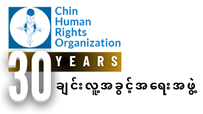VOL.III No.IV NOVEMBER-DECEMBER2000
VOL.III No.IV NOVEMBER-DECEMBER2000 HUMAN RIGHTS – Junta Orders Burning Of 16,000 Bibles, Halts Church Construction – A Reflection By An Eyewitness – Pu Do Thawng; Chin Political Prisoner – List Of Civilians Charged With “Unlawful Association Acts” – How The Burmese Soldiers Behave In The Village REFUGEES – Chin And Other Burmese Asylum Seekers In
